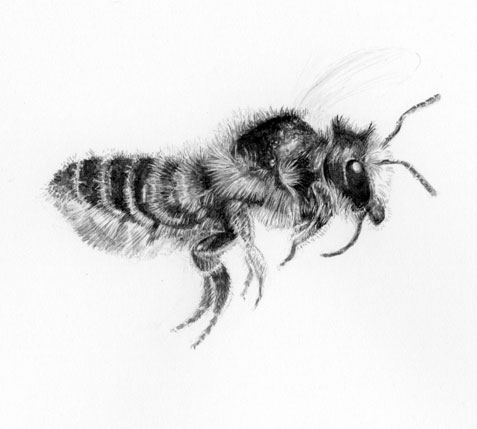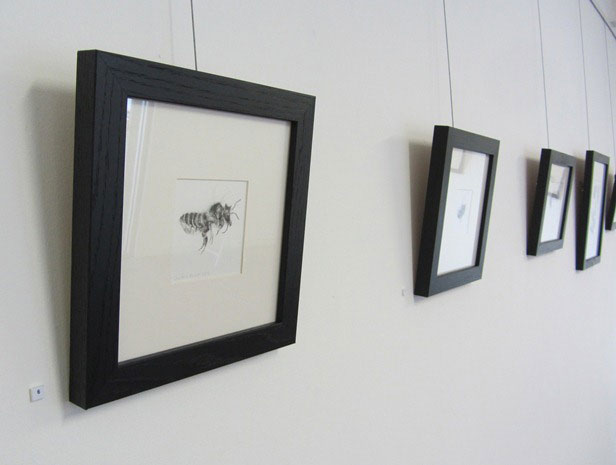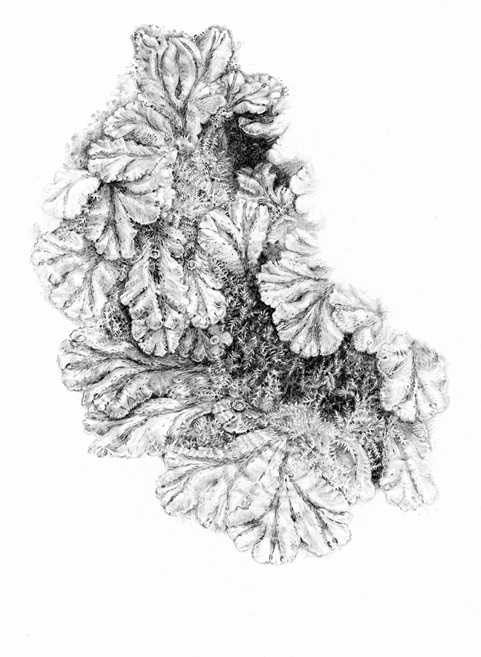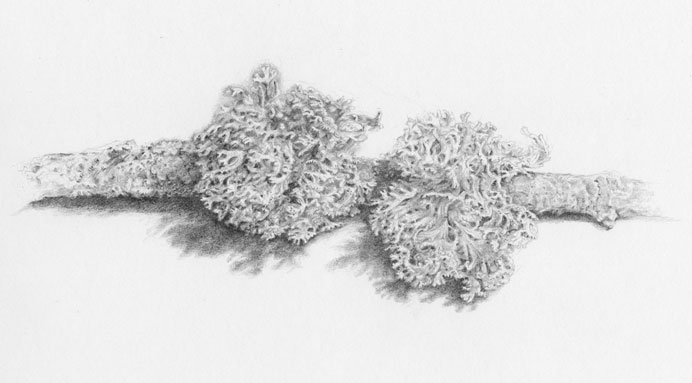“Leafcutter Bee in Flight”, 2012
Ink and brush on Fabriano paper, approx. 4.5″ x 7″
A solitary Leafcutter bee returned to lay in the bee houses this year. Due to the rain and cold weather she has completed less than one tube of cells this summer, on which the hope of leafcutters next year now rests. I will over-winter them in the tool shed to ensure cool, dry conditions, and hope for better weather at hatching time next spring.
On the positive side, this bee has been feeding in the garden, and I have taken many photos of her on the poppies and cornflowers. I will be drawing from these over the coming weeks, and posting the results here.
The drawing above of the Leafcutter in Flight is approximately 4.5″ x 7″, on Fabriano paper using Winsor and Newton Liquid Indian Ink applied with small watercolour brushes. A description of my method of work can be seen in this earlier post on a Leafcutter bee emerging from its nest at the beginning of the season. More of my leafcutter bee drawings can be seen in this gallery of drawings of leafcutter bees. And I go into more detail about the drawing techniques on this page on the lives of leafcutter bees.
You can read an interview with me in Bee Mentor which looks at my interest in leafcutter bees, but also covers my drawing techniques and practice, and my photography.
| Home | About | Contact | Galleries | Subscribe to Blog |




I must count myself lucky then, as three Leafcutter bees have visited the bee houses in my garden this year and have completely filled their tubes with cells.
Mason bees seem to have fared much better and many of the tubes are completely full, all nicely ‘bunged’ up at the ends with mud. Hope for next spring for Mason bees is high, for Leafcutters a more precarious future I fear.
My bee houses face almost due south and are against a warm kitchen wall – being in the south east of the Chilterns we have not fared as badly with rain as some areas of the UK.
That is very good news, Elissa! I do know that there are leafcutters nesting somewhere near here and not in my garden, as there were leaf circles missing from my roses a few weeks before my bees had hatched! And one year I had no leafcutters at all in my nests (the year of the wobbly bee houses), but they returned the following Spring. So there is always hope!
I love your bee pages and hope your population of leafcutter bees rebounds. The most magical garden moment of my childhood garden memories was watching a bee cut rose leaves… Thank you so much for your beautiful work.
Thank you for taking time to comment, Marzie, and for your good wishes! It really is an amazing thing to watch the bees cutting the leaves, isn’t it?
Just spending a lovely afternoon watching a gorgeous leaf cutter working hard bringing leaves into a little hole in my garden wall. Given the strange weather conditions we have at the moment, if things turn bed is there anything I can do to help her along
I mean’t bad not bed…….predictive text !!!
Hello! Lucky you – I have moved house from the place I used to watch the leafcutter bees, and though I have seen a few ‘cut’ leaves in my new garden, I have no leafcutters nesting as yet! Aren’t they fascinating to watch?
As far as helping your bee if the weather turns wet/. Is the place she’s nesting relatively sheltered from rain? I expect the bees are quite clever at selecting a good nesting spot, but perhaps if there are not many available holes then maybe they will used ones which may get wet over winter. However, they do seal the front of the nest with many, many layers of leaves which should ensure the cells inside are safe. As the nest is within a wall it’s no use suggesting you bring it into a cool shed to over-winter, which is my usual advice. So, in short, I would say that as she is nesting in a wall, there is not much you can do to ensure she has protection from wet, but trust she knows what she is doing and will seal the end of the nest well.
Hope you enjoy watching the new bees emerge next spring!
Just to update, I actually have four leaf cutters ( I think) working the same hole in my garden wall ( approx 10 cm * 2cm hole). My guess is that there is a cavity inside that opens into several different areas. Also, just opposite the wall my house has timber lintels over the back door and windows. Over these lintels are a number of plastic tubes (not great at builders language so I’m sure that’s not what they’re called) that various bees have been going in and out of. Almost all are now sealed. Would these be leaf cutters or masons I wonder ? My front garden has a beech hedge and there are loads of flowers about – I guess that’s why we’ve turned into leaf cutter central.
Hello again, Dylan. It sounds unusual to have four bees going into one hole, but it does sound quite wide at 2cm so perhaps it does open out in some way behind, as you say. I would be interested to see pictures or a video!
As for the bees in the plastic tubes. Mason bees would be making and sealing a nest with mud, which they carry into the tube in small balls. The leafcutter would be taking in pieces of leaf about the same size she is. So you should be able to tell from what they’re carrying. Otherwise, have a look once the nest is finished – whether the end is sealed with mud or leaves pressed into the hole.
Also, a little update on my bees. As you had written to me about your leafcutters I checked again on the seemingly abandoned or unhatched nest that I’d bought from my old house and yes! At least one tube of leafcutters has hatched in the past day or two, and one has already cleared the leaf debris from the old tubes, and is beginning to make new cells.
So it seems the bees have survived the move and I can begin to build up my little colony in my new garden.
Good luck with your bees, Dylan. Sounds like they have good nesting material nearby? Then one other thing you can do for them is to provide plenty of flowering plants for food. Try to see which flowers they are favouring, and go for more of those. Best of luck!